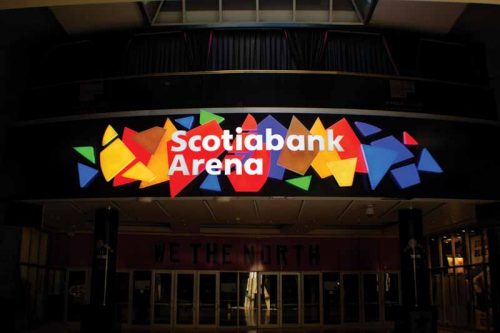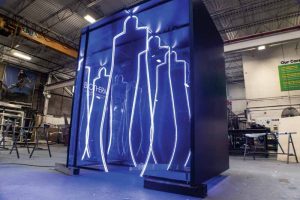
As a creator of both internal and external environments, Twilight Signs helps its clients achieve brand consistency and a more holistic experience.
SMC: How much of the signmaking process is handled in-house? What equipment do you currently use to complete your projects?
BH: I can proudly say 85 per cent of our sales are a direct result of our in-house production, whereas specialty products are outsourced. Also, we have partners overseas who supply materials either unavailable in North America or at a competitive price, allowing us to resell to the same market at profitable rates. Currently, we use computer numerical control (CNC) machines, automated letter forming equipment, as well as large-format digital and 3D printers for our signmaking projects.
SMC: What does your planning and design process involve?
BH: At Twilight Signs, the process from inspiration to installation is four-fold: discover, design, plan, and build.
The first step involves collaborating with clients to understand their goals and requirements. This information helps the team complete initial research, including audits and code checks, early site surveys, and a review of brand standards to develop a project brief before diving into concept development and design exploration.

Some of the sign shop’s interior signage projects include directional and illuminated signs, modern Acrylishell letters, and silicone-edge graphics (SEG) FabriBright Slim lightboxes.
Next, we move on to the design phase—this is where all the creative magic happens. Our team explores unique ways for extending the client’s brand into multiple dimensions. We ensure our innovative ideas in design, materials, and technology make the brand stand out from the rest. Together, we work through an iterative process to shape a space that is forward-thinking yet customer-centric. The third step includes proactive planning, which not only reduces the client’s workload, but also keeps them informed every step of the way. Experienced project managers are responsible for overseeing this stage—from concept development and design to site surveys, permits, and the final installation. Last but not least, our manufacturing capabilities enable us to make the leap from pixel to physical, with a focus on quality, efficiency, and speed. Our in-house team comprising skilled fabricators, welders, painters, technologists, and artisans help bring the client’s vision to reality. If one can imagine it, we can make it.
SMC: How is technology changing your business?
BH: Times have changed, and today, the biggest challenge is how online shopping is affecting in-store traffic. Customers do not need to go outside of their homes to buy products like they did 20 years ago. Almost all brick-and-mortar business owners are reinventing their client experience to inspire those visiting their shops. Physical spaces must be able to stimulate all the senses to draw customers out of their homes. That said, most of these senses cannot be stirred online, and this is where physical stores have an edge over the former. However, if businesses do not get this experience right in the first place, then the virtual aspect is perceived as adequate. Therefore, it is critical for companies to invest in creating experiential brand spaces that house cognitive and/or emotional values in their makeup if they wish to cultivate an ongoing relationship with their clients.





